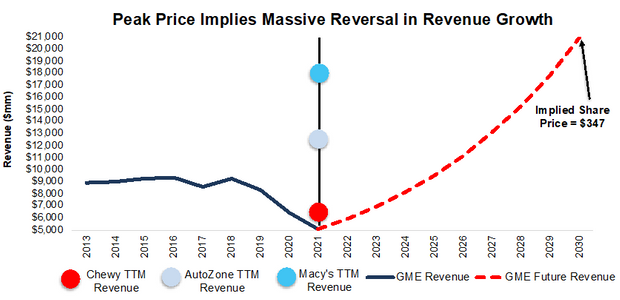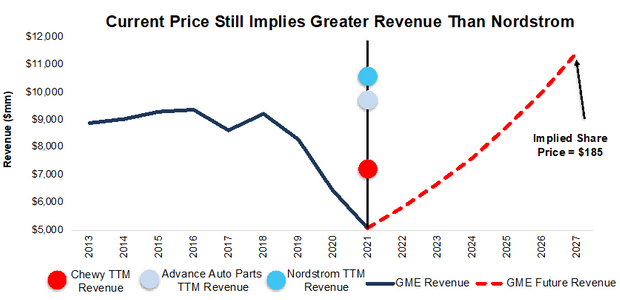GameStop was not worth owning anywhere above $45 a share, given the company’s fundamentals, as explained when we closed our Focus List: Long position in the stock in late January.
Nevertheless, the stock GME, -0.07% went on to climb as high as $347, even higher intraday, before taking a roller coaster path back to around $185.

To give readers a sense of just how crazy overvalued the stock was at its peak, we do the math and show how the business would have to perform to justify a share price of $347.
“Crazy” at $347 explained: It implies more revenue than Macy’s
To justify $347 a share, our reverse discounted cash flow (DCF) model shows that GameStop must:
- Improve its profit margin to 5.5% (10-year average from 2010-19 is 3.9% and the all-time high was 4.8% in 2008), and…
- Grow revenue by 17% compounded annually through 2030 (above the projected videogame industry CAGR of 13% through 2027).
In this scenario, GameStop earns nearly $21 billion in revenue in 2030 or more than the trailing-12-months (TTM) revenue of Macy’s M, -2.52%, AutoZone AZO, -1.26% and Chewy CHWY, +3.97%.
GameStop’s historical revenue vs. DCF implied revenue: Scenario 1

For reference, GameStop’s revenue fell by 3% compounded annually from 2009 to 2019.
Still Crazy at $185
For perspective on the current price, we run the same analysis to show what the company must do to justify $185 a share:
- Immediately improve its profit margin to 4.8% (all-time high in 2008 compared with 0.7% in 2019).
- Grow revenue by 15% compounded annually through 2027 (above projected videogame industry CAGR of 13% through 2027).
In this scenario, GameStop earns over $11 billion in revenue in 2027, which is 19% higher than GameStop’s record revenue of $9.6 billion in 2012 and the TTM revenue of Nordstrom JWN, -3.14%, Advance Auto Parts AAP, -0.35% and Chewy.
GameStop’s historical revenue vs. DCF implied revenue: Scenario 2

Sure, stock prices can be irrational
We are not saying that fundamentals should be 100% of your investing process. We only aim to add insight into the fundamental risk of owning stocks at different prices.
We’re not saying that you will not make lots of money trading stocks. You might. Our aim is to provide some fundamental perspective to inform and complement other investment strategies. In other words, if you have 10 great technical ideas, you might like to overweight those with the best fundamentals and underweight those with weaker fundamentals.
With a better grasp on fundamentals, investors have a better sense of when to buy and sell – and – know how much risk they take when they own a stock at certain levels.
Now read: GameStop to retire some debt early to ‘strengthen balance sheet’
David Trainer is the CEO of New Constructs, an independent equity research firm that uses machine learning and natural language processing to parse corporate filings and model economic earnings. Kyle Guske II and Matt Shuler are investment analysts at New Constructs. They receive no compensation to write about any specific stock, style or theme. New Constructs doesn’t perform any investment-banking functions and doesn’t operate a trading desk. This is adapted from a report entitled “Saving Investors from Meme Stocks: GameStop.” Follow them on Twitter@NewConstructs.








